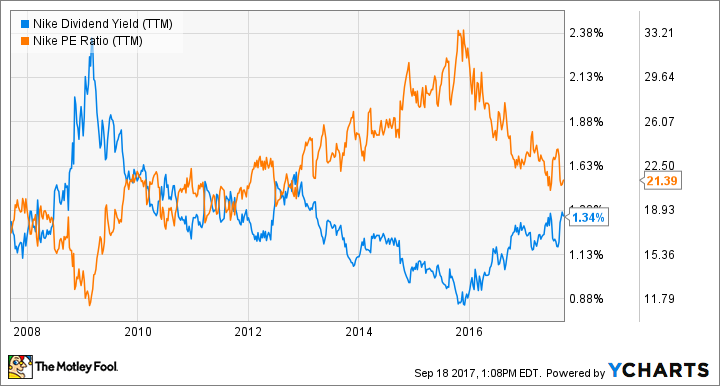Nike's (NKE 1.55%) stock has been flat over the past year, as sales growth has been lower than investors expect, especially given that Nike was valued at a high price-to-earnings (P/E) ratio of 30 in early 2016. High valuations demand high growth, and when growth disappoints, stock prices usually suffer the consequences.
Meanwhile, Adidas (ADDYY 5.60%) has been invading Nike's territory in North America with renewed energy, posting robust sales growth over 20% compared to Nike's paltry single-digit sales growth. However, I don't believe this is the time to throw in the towel on Nike, which has one of the most iconic brands in the world. Both companies operate in a huge athletic apparel market that generates about $300 billion in annual sales, and there's good reason to expect Nike to bounce back.

IMAGE SOURCE: NIKE INC.
Athletic apparel is a big, growing market
Athletic apparel has been a bright spot in a sluggish retail environment. Since 2013, apparel sales have increased less than 3% per year, but athletic apparel

IMAGE SOURCE: GETTY IMAGES
has been growing faster. Morgan Stanley estimates that athletic sales have grown 61% since 2007, with sales expected to grow another 22% through 2021.
But the major brands are capable of much faster growth than that. Many retail brands, including Nike, are still catching up to the robust growth taking place with online shopping. In addition, one survey found that nearly half of consumers want their favorite apparel stores to offer new styles at least once per month.
Nike has heard the call and is responding. The Oregon-based company has been investing heavily in its supply chain to increase the speed it gets new styles to market. This will help Nike meet the immediate demand at stores and generate better sales performance, which will boost margins. A faster supply chain will increase the amount of product that sells at full-price and reduce the amount of product that gets marked down due to low demand.
Adidas and Lululemon Athletica are also improving their supply chains, but that isn't a negative for Nike. It's a positive, because it validates the industrywide opportunity in a growing athletic wear market.
Because only large brands like Nike have the resources to make these major investments, Morgan Stanley expects the top brands to capture the majority of the athletic apparel industry's profit over the next five years. As Nike increases the speed with which it delivers new styles to consumers faster than smaller competitors, it's brand should get even stronger.
Nike has lots of promise
Nike's P/E ratio has dropped from about 30 over a year ago to the low 20s -- the lowest Nike's P/E ratio has been in five years. Nike's dividend yield now sits around 1.3% and the company has been increasing its annual dividend since 2004.
NKE Dividend Yield (TTM) data by YCharts
Recent weak sales have clearly given investors pause. Investors are concerned about Adidas and whether it's taking share from Nike. But Adidas' faster growth in North America could be as much due to Adidas catching up after being under-represented in the U.S., where Nike already has a strong presence. After all, Nike posted much better growth in Western Europe and China of 11% and 17%, respectively, in the fourth quarter.
Nike is still recognized as one of the top brands in the world. Forbes ranked Nike the No. 16 most valuable brand for 2017 -- which places Nike as the No. 1 apparel brand overall. Uncertainty about near-term growth may have caused short-sighted investors to back off from buying Nike's stock, but now could be a good time for long-term investors to buy a piece of one of the most valuable brands in the world at the lowest P/E it's been in several years.
The company is scheduled to report earnings on Sept. 26. Investors and would-be investors should tune in for a look at how things are going at this brand powerhouse.






